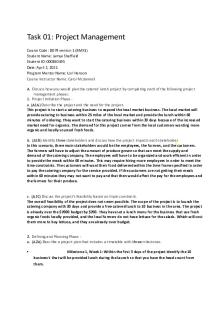Task 1 - Submitted, but don\'t know if I passed... PDF

| Title | Task 1 - Submitted, but don\'t know if I passed... |
|---|---|
| Course | Introduction to Curriculum, Instruction, and Assessment |
| Institution | Western Governors University |
| Pages | 3 |
| File Size | 95.9 KB |
| File Type | |
| Total Downloads | 109 |
| Total Views | 138 |
Summary
Submitted, but don't know if I passed......
Description
A. Case #1248 Utilizing Bloom's Taxonomy to Engage in Meaningful Discussion Description 1. The teacher in this example was using a group discussion designed and led by her top preforming students to assess what the students were learning from reading their book, There Are No Children Here. As the teacher walked around the classroom, she notices a group where the discussion leader has been asking more “knowledge based” questions than the “higher level” questions she was looking for. After seeing their performance was not meeting the expectations of the assessment, the teacher chose to ask the students her own question to get them on the right track with the assessment. By modifying the formative assessment, the students were able to more accurately participate in the formative assessment activity. Feelings 2. There is a boy, Ryan, in this group. Ryan is at first preoccupied with completing the activity in the way his peer, Andy, designed it. This changes when the teacher modifies the assessment by asking a different question. Ryan is more focused on the original intent of the formative assessment, which is discussion. He is engaged and participating in the discussion. This leads me to believe while he liked the game his friend planned; he also liked the discussion aspect of the teacher’s modified assessment. Evaluation 3. The teacher’s original intent of this formative assessment was “…problem solving skills by working with peers to comprehend, ask/answer questions, clearly convey students' own ideas, and explain their reasoning.” She did not feel the group leader, Andy, was helping the students in his group demonstrate these skills, because he was asking closed ended, “Jeopardy style”, questions. After the teacher stepped in and modified the formative assessment, the students were asked an open-ended question about why they thought the character in the book was asked to leave her apartment. This question sparked further discussion. This portion of the video shows the teacher’s modification was a success because after the modification, the students were successfully able to demonstrate the skills she was trying to assess in this activity. Analysis 4. The teacher noticed the way one of the group activities was designed was not allowing her to effectively assess the students for the standards she was looking to assess. She was looking to assess standards such as explaining their reasoning through the use of an open ended question formative assessment. The leader of one of the groups was asking close-ended questions, so it was not necessarily the data she gathered that made her modify the assessment, but the lack of data collected from the assessment that made her modify the assessment. I think that is why she chose the modify the assessment, so she could better assess the standard of being able to justify their reasoning. (Atlas, 2014) Conclusion 5. The teacher in this scenario is a strong teacher. She is playing to all her students’ needs. She has some high-level students who were benefited from being the leader of the group and the one to choose the open ended questions. The leader of the one group was trying to make the assessment activity more “engaging” for some of the students in his group. He had great ideas; however, it was not meeting the assessment criteria the teacher needed. She was able to quickly identify the problem and stepped in to guide the activity in the right direction to get what she needed for her formative assessment. If a teacher does not make those kind of instant reflections and modifications, she will not be able to best help her students meet or exceed the standards of learning. For example, if the teacher in this scenario had not stopped at the group, listened to the quality of data the formative assessment was getting, and modified the assessment, she would have incorrectly presumed all the students were working at the standard needed to complete an argumentative essay assignment the following week. IF you are not constantly assessing, reflecting, and changing, you will not see as much success in your classroom for ALL students.
Action 6. I had never thought about using the small group discussion to conduct a formative assessment. But if you are circulating, listening, and making assessments, it is a great way to conduct an assessment. I also loved how she put her high-level students as leaders of the groups, who came up with the questions to ask the students and guided the discussion. I think this strategy could be used in younger grade levels too! If you have high-level students, why not have them help design a formative as part of their enrichment? This stragegie would help all students, not just the higher level, because peer teaching can be an effective way to reach the lower level students. B. Case #190 Writing Cause and Effect Sentences. Description 1. The teacher in this video differentiated instruction at the 6:24 mark. There were two different versions of the worksheet activity he gave the students to complete. The more advanced students were tasked with writing an entire cause and effect statement sentence. The students who were lower level in this activity got a worksheet with the sentence premade and the students just needed to fill in the blanks. Feelings 2. At around 9:11 of the video, the teacher has tasked students with completing their worksheets. There are several students able to complete the more difficult work sheet on their own. The students seem to feel capable in the task, since they are already writing sentences on their own. At the 10:32 mark, the teacher is assisting a student who is working on the less difficult worksheet. The student here seems to be feeling lost. They are sitting back in their chair, and sort of playing with their pencil on the side of their paper. The teacher picks up on these cues that she might be having a difficult time and walks her through the first sentence. Once the teacher has given the student guidance, she sits up straighter in her chair, and begins to write. To me, this suggests she is feeling confident with the task now and has an idea of what to do. (Atlas, 2014) Evaluation 3. The way this teacher chose to differentiate the worksheet activity was successful. The students who needed a challenge were able to challenge themselves to write their own sentence. The students who needed more support to write a cause and effect sentence got the scaffolding they needed to achieve the goal of the activity. Analysis 4. The teacher knew not all the students are strong enough in writing English to be able to write a cause and effect sentence on their own. Although the lesson is the same for all the children, some of the English language learners are more advanced in their learning. Since they are learning English, the students come in with a variety of background levels of experience with English. Some are learning from Spanish based languages that have a lot of similarities to English. Other students are coming from a picture based first language and learning to write sentences in English is significantly more challenging. Conclusion 5. Even though the teacher already differentiated the activity to better fit learning levels, the teacher walked around the classroom visiting with the students. At the 11:30 mark, there is a student still struggling with the lower-level worksheet. The teacher has the boy pair up with another student working on the more difficult worksheet. The students take turns reading sentences, and the boy makes a sentence that is not yet written. The teacher praises the sentence, and then encourages the student, “Now write that down, right here.” Another student, at the 10:34 mark, the teacher is helping a student change “clothing” to “clothes”, and also helps her locate a list of possible words to use in her sentence. Just because the teacher has given two different activities for different learning levels, he did not just sit at his desk and say “figure it out.” You might have a level 1 and a level 2 worksheet, but within the classroom, you have level .50, .75, 1.25, 1.75 and even some 2+ levels of students. He still made sure
he met each of them at their level and gave them a worksheet they could be successful with. (Atlas, 2014) Action 6. I liked the first strategy of providing different worksheets. I feel like that was a great start to helping each student feel successful in the activity. After that, I really liked when he paired the students up and had them read their sentences to each other. The stronger students can feel success in being the “teacher” and the lower students can feel success by getting the help they need. C. By using a formative assessment, the teacher knows where best to reach their students in their differentiation efforts. Before you can meet a student “where they are” you have to KNOW where they are. For example, the teacher in part B can’t just randomly give out the two different worksheets he has. He needs to match each worksheet to the ability level of the student; therefore, we know he has done some assessment to know which student needs the harder worksheets and which need the easier ones. In video A, the teacher has intentionally built her groups around having her most advanced students leading the groups. She wouldn’t know which students were the most advanced without some formal assessment to back that up. She also used assessment to check in with her strategy- she thought there could have been some better matchups within the groups, and maybe next time she will break up the groups differently, based on her assessment during the activity. (Atlas, 2014) D. https://atlas.nbpts.org/cases/190/ https://atlas.nbpts.org/cases/1248/...
Similar Free PDFs

COA+Syllabus - i dont know
- 3 Pages

TAT2 Task 1: Passed
- 14 Pages

C227 Task 1 - Passed Task
- 22 Pages

D082 Task 1- PASSED
- 2 Pages

C206 Task 1 V2 - Task 1 Passed.
- 11 Pages

Task 1 D091 done - Passed
- 6 Pages

D095 Task 1 passed WGU
- 3 Pages

Task2 - Task 2: Passed
- 3 Pages

C225 Task 2 (passed)
- 8 Pages
Popular Institutions
- Tinajero National High School - Annex
- Politeknik Caltex Riau
- Yokohama City University
- SGT University
- University of Al-Qadisiyah
- Divine Word College of Vigan
- Techniek College Rotterdam
- Universidade de Santiago
- Universiti Teknologi MARA Cawangan Johor Kampus Pasir Gudang
- Poltekkes Kemenkes Yogyakarta
- Baguio City National High School
- Colegio san marcos
- preparatoria uno
- Centro de Bachillerato Tecnológico Industrial y de Servicios No. 107
- Dalian Maritime University
- Quang Trung Secondary School
- Colegio Tecnológico en Informática
- Corporación Regional de Educación Superior
- Grupo CEDVA
- Dar Al Uloom University
- Centro de Estudios Preuniversitarios de la Universidad Nacional de Ingeniería
- 上智大学
- Aakash International School, Nuna Majara
- San Felipe Neri Catholic School
- Kang Chiao International School - New Taipei City
- Misamis Occidental National High School
- Institución Educativa Escuela Normal Juan Ladrilleros
- Kolehiyo ng Pantukan
- Batanes State College
- Instituto Continental
- Sekolah Menengah Kejuruan Kesehatan Kaltara (Tarakan)
- Colegio de La Inmaculada Concepcion - Cebu






